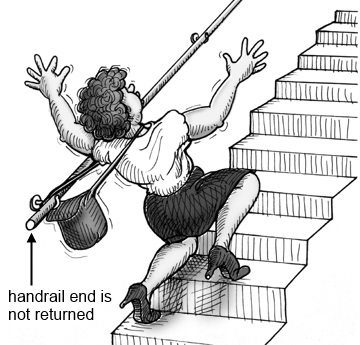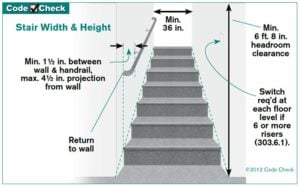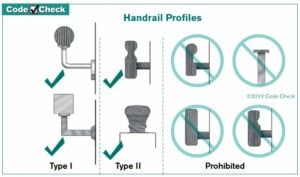When it comes to ensuring the safety of a building’s occupants, one often overlooked yet crucial element is the handrail. Handrails serve as a fundamental safety feature in staircases, walkways, and ramps, providing support and stability to those navigating these spaces. At Tennessee Inspection Services, we recognize the significance of handrails and their role in preventing accidents. In this comprehensive guide, we’ll delve into the safety requirements of properly installed handrails, including the necessity of returns, continuous design, appropriate height, and graspability.
The Importance of Handrails
Handrails are not merely decorative elements; they play a critical role in maintaining the safety of individuals as they traverse various architectural features. By offering support, balance, and stability, handrails significantly reduce the risk of slips, trips, and falls. Properly installed handrails also promote inclusivity by aiding individuals with mobility challenges, such as the elderly or those with disabilities, to move confidently and securely.
Continuous Handrail Design
One of the key safety requirements for handrails is their continuous design. A continuous handrail ensures that there are no gaps or interruptions along its length, providing users with a consistent and reliable means of support. This design prevents potential accidents caused by sudden breaks or changes in the handrail’s trajectory. Tennessee Inspection Services emphasizes the importance of selecting materials and designing handrails that maintain continuity, thereby enhancing user safety.
The Role of Handrail Returns
Handrail returns are the curved or extended ends of a handrail that prevent clothes or limbs from getting caught between the handrail and the supporting surface. These returns are an essential safety feature, as they eliminate hazards that could lead to injuries. For instance, a handrail without returns could snag a person’s clothing or cause discomfort while gripping. Tennessee Inspection Services strictly enforces the inclusion of handrail returns in all installations to mitigate potential risks and ensure a safer environment for building occupants.
Installed Height for Optimal Safety
The proper height at which a handrail is installed greatly influences its effectiveness in providing support and stability. According to safety standards, handrails should be installed at a height that allows users to comfortably grasp them while ascending or descending stairs or ramps. In most cases, a handrail should be positioned at a height of approximately 34 to 38 inches above the walking surface. This optimal height ensures that users can maintain a natural posture while holding onto the handrail, reducing the likelihood of accidents caused by awkward angles or inadequate grip.
Graspability: A Vital Consideration
The ability to grasp a handrail securely is paramount to its functionality. Handrails should be designed in a manner that allows individuals to hold onto them firmly without straining their wrists or hands. A round or oval profile with a diameter of around 1.25 to 2 inches is recommended to provide a comfortable grip for a wide range of users. Tennessee Inspection Services emphasizes that handrails should be free from any sharp edges, splinters, or obstructions that could hinder users’ ability to maintain a secure hold.
Materials and Durability
Selecting the right materials for handrails is another critical aspect of ensuring their safety and longevity. Handrails are often made from a variety of materials, including wood, metal, and composite materials. The chosen material should be sturdy, able to withstand the rigors of everyday use, and resistant to weathering, especially if installed outdoors. Regular maintenance and inspections are essential to address any signs of wear, corrosion, or damage promptly.
Visual Contrast and Visibility
Handrails not only serve a functional purpose but also play a role in enhancing the overall visibility and contrast within a space. Proper color contrast between the handrail and its surroundings is important for individuals with visual impairments. A handrail that stands out visually against the background helps individuals identify its presence and location easily, adding an extra layer of safety.
Installation and Compliance
While understanding the safety requirements of handrails is crucial, it’s equally important to ensure that installations adhere to local building codes and regulations. Tennessee Inspection Services is committed to upholding these standards and working with architects, contractors, and property owners to guarantee that handrails are installed properly and meet all safety requirements. Our goal is to create spaces that are not only aesthetically pleasing but also safe and accessible for all.
Conclusion
At Tennessee Inspection Services, safety is our top priority. Properly installed handrails are a fundamental aspect of building design that significantly contributes to accident prevention and user well-being. The inclusion of handrail returns, continuous design, optimal height, graspability, appropriate materials, and adherence to regulations all work together to create a secure environment for building occupants. By recognizing the significance of these safety requirements, we can ensure that handrails fulfill their intended purpose while enhancing the overall safety and functionality of architectural spaces.








